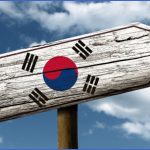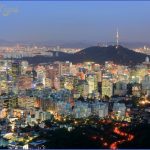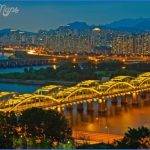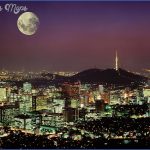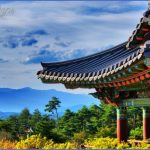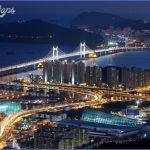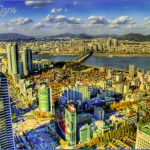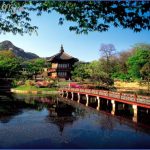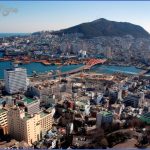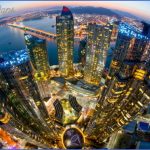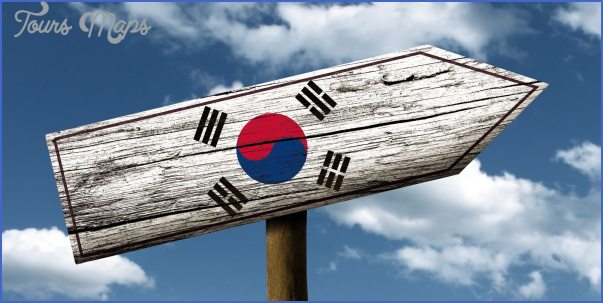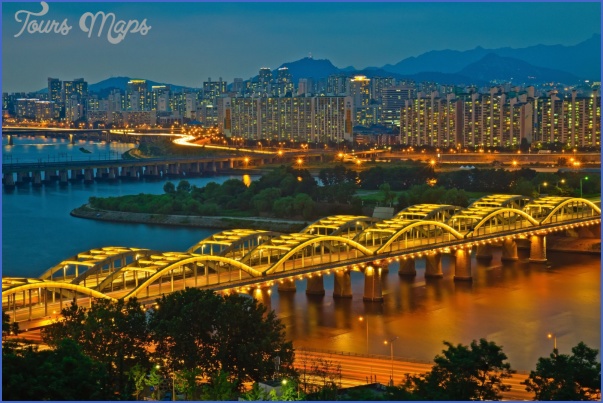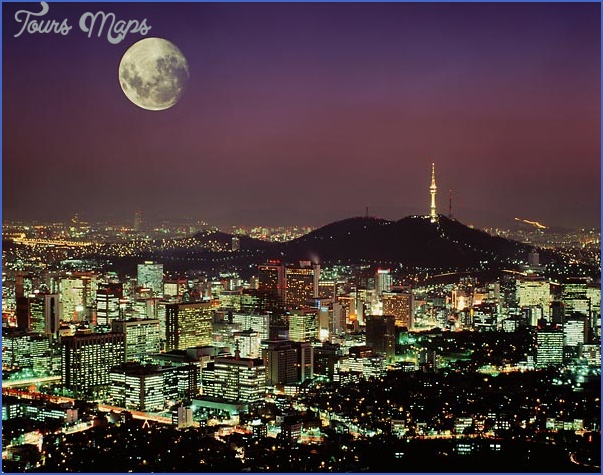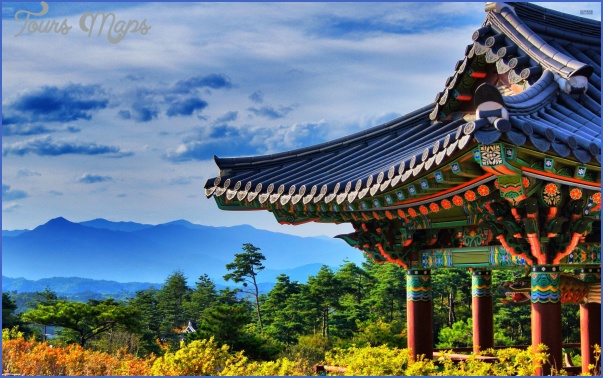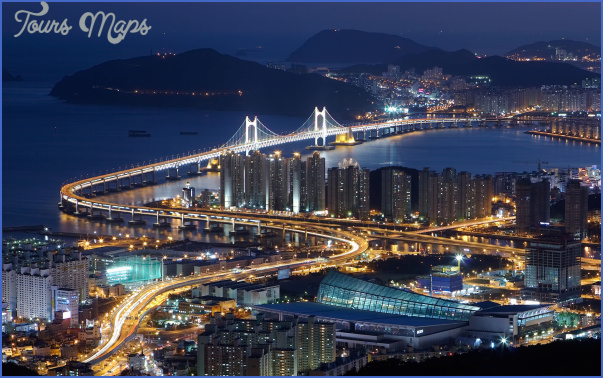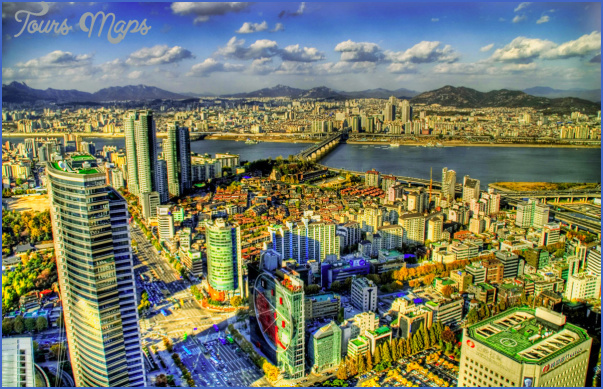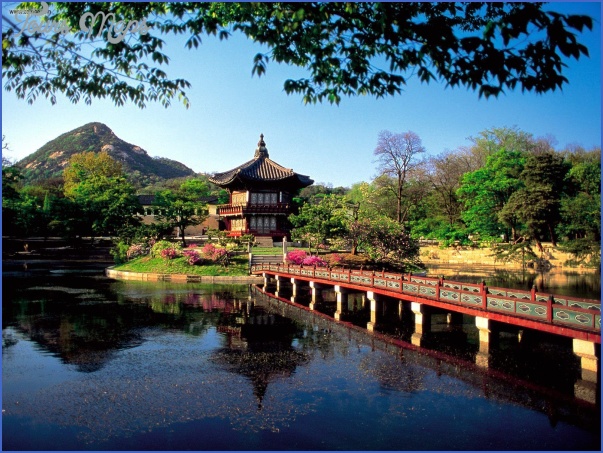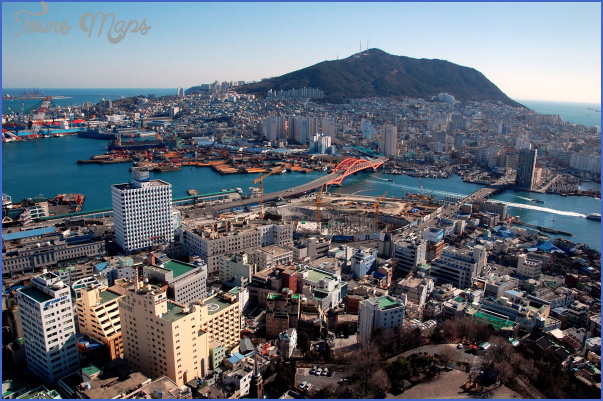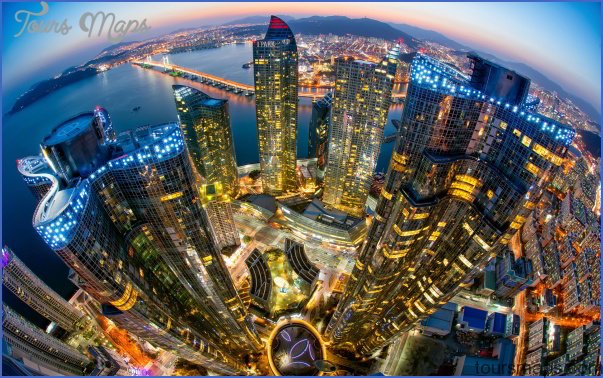Korea calls itself The Land of Morning Calm. Scenic beauty abounds. Depending upon location, winters can be very cold and summers hot and humid. The climate is varied. While U.S. service personnel are being raked by cryogenic blasts at Panmunjun on the border with North Korea, the island Cheju, where the principal crops are tangerines and pineapples, is experiencing a subtropical climate. Cheju sits on about the same latitude as San Diego and El Paso.
A direct flight from Los Angeles to Seoul, Korea’s primate city of eight million, takes twelve hours. Tokyo to Seoul is a two-and-a-half hour flight. Korea has three international gateway cities Seoul, Pusan, and Cheju Island. Regular connections are available between Seoul and Japan, Hong Kong, Taiwan, and Thailand. A flight to Korea can be part of an Asian junket, breaking up the long flight to Seoul by stopping in Tokyo, then on to Seoul, Hong Kong and back via Taipei and Honolulu. An interesting trip back from Korea can be done via the Pusan Ferry that takes seven hours and runs between Pusan on Korea’s east coast and Shimonoseki, Japan.
Getting around Korea is easy. Super-express trains operate between the major cities. The run between Seoul and Pusan, Korea’s second city in importance, takes five hours and forty minutes. Bus service is frequent.
Shopping in Korea means ceramics, lacquerware, silk, dolls, brassware, tailored clothing and, yes, good old ginseng and wigs. Myongdong, Korea, is Korea’s answer to Tokyo’s shopping and entertainment center, the Ginza. The amount of ginseng taken out of the country is limited. Travelers can take out a maximum of five ladies’ wigs, three gentlemen’s wigs, not more than twenty cuttlefish or two hundred pairs of false eyelashes. Pity the poor tourist who needs a lifetime supply of eyelashes and is just crazy about cuttlefish.
South Korea has twenty-five thousand hotel rooms, about ten thousand of them in the country’s capital, Seoul. Hotels are rated, five stars being the top award. Fourteen hotels have the five-star rank, among them the Hotel Lotte and the Hyatt Regency. The Japanese are Korea’s biggest visitor group, many of them males come to enjoy the Korean women. A total of about 1.1 million visitors arrive in Korea each year.
Korea is one of the few countries where travel agents and hotel managers must pass an examination to be licensed. The same is true for tour guides, interpreters, and overseas escort ers.
Japan has its Ryokan; Korea its yokwans, the country inns. Unlike the Ryokans which can be very expensive, the yokwans are cheap. Guests sleep on the floor on a mattress. The pillow or headrest is often filled with buckwheat husks. The heating system may be the ondol, or hot floor, the heat applied from below the floor. The Ryokan offers elaborate meals. In the yokwan food must be ordered from outside and eaten in the room.
Hotels in Korea are classified into Deluxe (A), First Class (B), Second Class (C) and Third Class (D). Rate ranges are government mandated. Thirteen hotels are rated in the deluxe category. Visitors report that the service is unexcelled.
A spiny backbone of mountains runs down the middle of Korea so that only about one-fifth of the land can be cultivated. The coastal plains of the west and south produce most of Korea’s rice, the Orient’s equivalent of bread. Sweet potatoes, cabbage, turnips, cucumbers are common vegetables.
Visitors to Korea’s restaurants can try a number of foods, some common to other Oriental countries, others unique. (Puppy dogs and snakes have been ordered off the menus of restaurants for fear of offending tourists.) Dinner might begin with Kujolpan, an hors d’oeuvre tray with a difference. Cooked meat and vegetables are arranged on a large platter in a circle of contrasting color. A mound of paper-thin pancakes is piled in the center. The pancakes are picked up with chopsticks, meat and vegetables placed on them, the pancake rolled up and popped into the mouth.
A main course could be Sinsollo, a mixture of meat, fish, vegetables, and bean curd over which beef broth has been poured. This cooks in a brass bowl which encloses a brazier filled with red-hot charcoal. Pulgogi, marinated beef sliced paper thin and grilled over charcoal, is the best known meat dish in Korea.
Soups containing seaweed, meat or fish are always served. Seasoning includes red and black pepper, garlic, seasame seed oil and soy sauce.
Kimchi is a highly seasoned and fermented pickle of cabbage, turnip or cucumber, Korea’s staff of life, usually eaten three times a day. Pungent smelling, kimchi is not to every visitor’s taste. Some eat it out of self-defense. Stored in large pots, it comes in summer and winter forms. Red peppers add fire to the cabbage to make a dish that westerners may find too much. Kimchi provides vitamins B,, B2, B12, and C, plus iron, calcium, and other minerals.
For those who need to be jump-started, ginseng is said to be the answer. Korean ginseng is said to be the best. Its vaunted aphrodisiacal power may be due only to the fact that the heart is stimulated.
Beer halls where patrons are expected to at least buy a dish of snacks peanuts, dried fish or raw vegetables are fun places. Wine houses called subjip are the working man’s bars. Makkolli is a milky-white brew made from rice. Soju is particularly potent. Accompaniments include green onions, garlic, and sesame leaves. Pachon, fried leeks with small shelled clams in an egg batter, and todorimook (wild acorn gluten) are there for the adventurous.
There are also tabans, tearooms (ta means tea; bang means room). During the summer, strawberry, watermelon, peach, or apple juice may be served. Barley tea is always available.
SOUTH KOREA Photo Gallery
Maybe You Like Them Too
- Explore Doncaster, United Kingdom with this detailed map
- Explore Arroyito, Argentina with this Detailed Map
- Explore Belin, Romania with this detailed map
- Explore Almudévar, Spain with this detailed map
- Explore Aguarón, Spain with this detailed map

